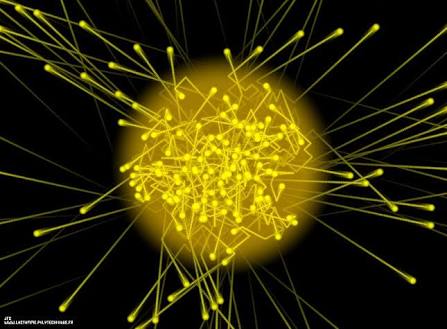photon: a closer view
.jpg)
src
The imagery you are seeing above is an artistic impression of the photon particles. These particles can travel across the earth seven times in one second, and it takes only eight minutes to reach the earth from the sun. You actually get hit by them every other day. The visible lights we see are actually carried by photons. The photon particles can also be referred to as light quantum, minute energy packet of electromagnetic radiation.
A photon is a particle of light defined as a discrete bundle (or quantum) of electromagnetic energy. Photons are always in motion and in or vacuum (a completely empty space), have a constant speed of light to all observers.
Photons travel at the vacuum speed of light. C= 2.99x108

src
BASIC PROPERTIES OF PHOTONS
I would attempt to outline some basic properties of photons: According to the photon theory of light, photons
Photons can behave like a particle and a wave at the same time.
Photons move at constant velocity in empty space
Can be created/destroyed when radiation is absorbed/emitted
The rest mass of a photon is 0.
We learned earlier that objects with nonzero rest mass cannot propagate with the speed of light. This comes from the fact, that if you calculate the dynamical mass for greater than 0 and v=c, you get nonsense, a diverging expression. It looks as if the dynamical mass became infinite, which means the energy of the particle became infinite. However, if the rest mass is zero, you get 0/0, which in mathematics means an arbitrary number. By using mathematical tricks (limits), one can still extract some information from such limits and get a meaningful value for the dynamical mass.
The dynamical mass of the photon is

The momentum of a photon is p=mc
(just as in classical physics, momentum equals mass times speed) which gives us

A BRIEF HISTORY
The concept originated (1905) in Albert Einstein’s explanation of the photoelectric effect, in which he proposed the existence of discrete energy packets during the transmission of light. Earlier (1900), the German physicist Max Planck had prepared the way for the concept by explaining that heat radiation is emitted and absorbed in distinct units, or quanta. The concept came into general use after the U.S. physicist Arthur H. Compton demonstrated (1923) the corpuscular nature of X-rays.1
EVERY DAY APPLICATION OF PHOTON
Photon is the foundation of light and as such has a lot of application in real time. They are used in practically any and everything to relate with light usage. Examples of photon.
Sunlight
Camera
X-ray
Uv radiation
The visible light we see
A big thanks to Enstein who has helped us appreciate the concept of photon in everyday life. Sometimes we do enjoy the several spectrums of light but we however may not think of what component it is made up of.
They are of course photons. Photons play vital role in our understanding of the concept of relativity and the speed of light.
References
what exactly is photon
Basic properties of photon
If you write STEM (Science, Technology, Engineering, and Mathematics) related posts, consider joining #steemSTEM on steemit chat or discord here. If you are from Nigeria, you may want to include the #stemng tag in your post. You can visit this blog by @stemng for more details. You can also check this blog post by @steemstem here and these guidelines here for help on how to be a member of @steemstem.